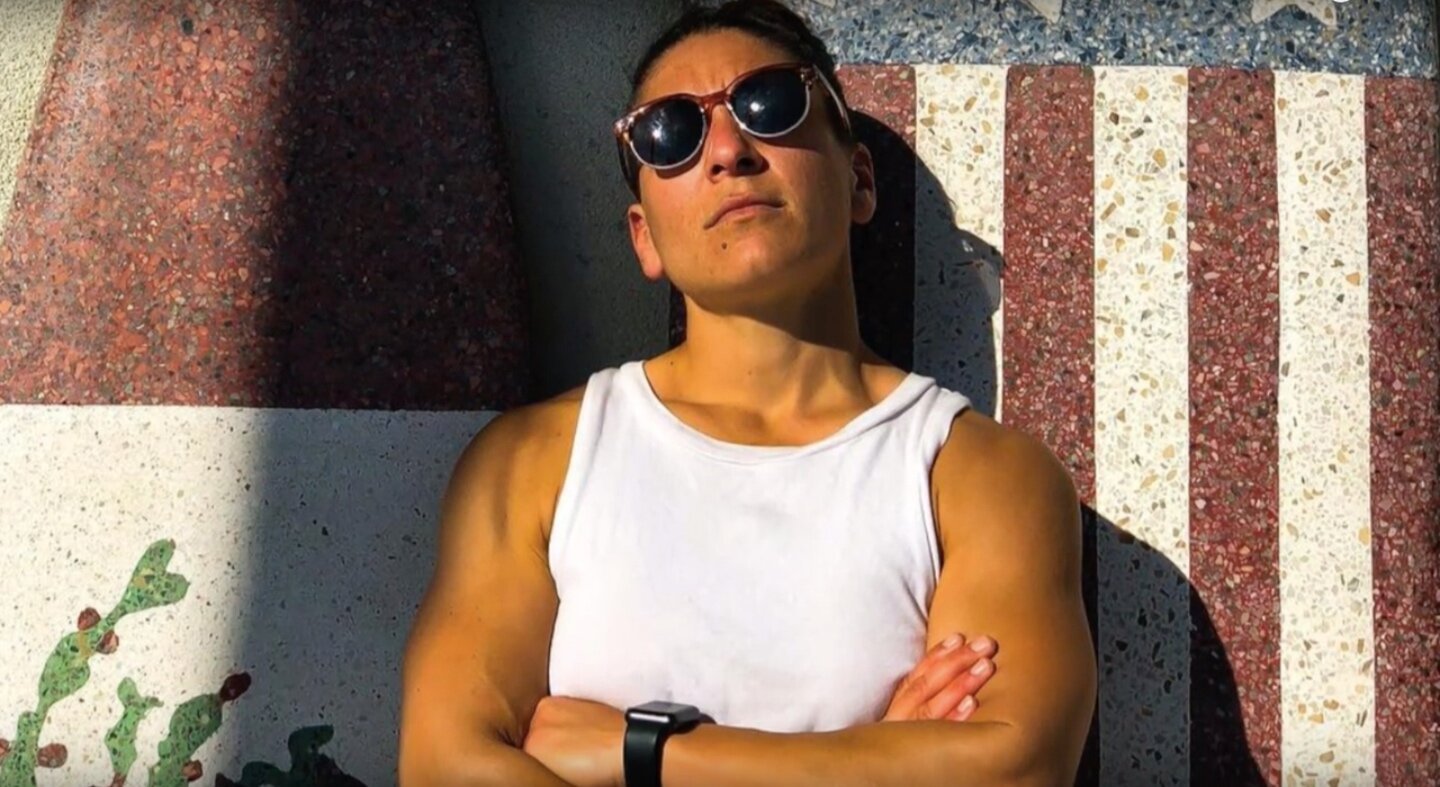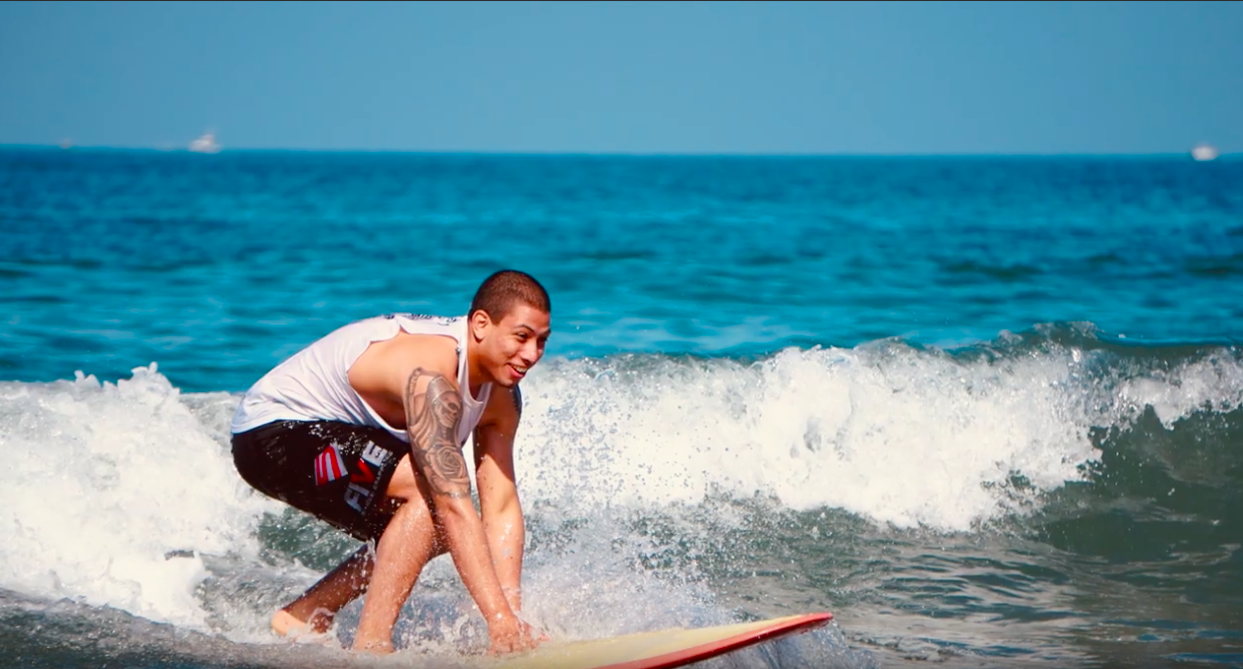The Subject: Courage. The Classroom: The Ocean.
Courage Camps started by accident. Cassie Comley, Vannessa Yeager, and Giselle Carrillo sought to carve out a welcoming space for their East Los Angeles community to connect with the ocean. It wasn’t long before as many as thirty people started showing up to the gatherings. They meet at Newport early in the morning to brace the chilled water. Equipment, as Cassie puts it, is “collectively supplied.” They find wetsuits on OfferUp for free or cheap. People come with extra boards. “It’s really cool to see people show up, ready to share what they have.”
Cassie, like Giselle and Vanessa, has roots in the L.A. area. Her grandfather, a beneficiary of the G.I. bill, moved the family to Buena Park in Orange County when her mom was a teenager. “That was seen as the path to assimilation,” Cassie says. “My mom and uncle were the only brown people at their high school.” Her mom always wanted to be a surfer. She wore red Vans because that’s what all the surfers wore – but at the time, the color red was also associated with gang culture. “Due to her skin tone, and how she looked, and how people perceived her – they assumed that she was in some kind of gang.”
“My mom always carried the beach with her,” Cassie says, “but never really stepped into that world.” At sixteen, Cassie found her own way to surfing. “I was the girl sitting on the beach, waiting for the boyfriend to get out of the water… and I got tired of it, because I grew up really tough. Skated, biked, did it all. [At that time] I was still finding my feminism, my grounding. We didn’t have a lot of money. We all shared surfboards. We didn’t have wetsuits, so surfing in the winter, it was cold. You dealt with it. I didn’t meet another female surfer until I was twenty-three or twenty-four.”
Pictured: Cassie Comley, Ph.D.
“We all shared surfboards. We didn’t have wetsuits, so surfing in the winter, it was cold. You dealt with it.”
Vanessa Yeager caught the surfing bug at a young age. “I lived in Moreno Valley, so I wasn’t close to the beach. I had to watch it on TV, watch the videos, get the magazines. Any magazines that I could get my hands on, or books, I was reading. I just really was like, I gotta get to the beach!”
Vanessa taught herself how to surf. People would give her old boards. “I was flailing for a good five years. Just out there, trial and error.” She caught her first wave on a family trip to Santa Barbara. “My mom was so cool. She did not understand my vision at all, but she was like, alright, mija, you wanna surf? Here’s the beach...so I was like dang, okay, I’m gonna do this! So I went out there, and I think I drowned,” she recounts laughingly.
At twenty-one Vansessa began entering surf competitions, but the contest fees and gas to get there were barriers. “I made it my life’s mission to move to the beach. My family thought I was crazy. I think they still do...they still don’t quite understand it. But that’s okay. I came to my own realization that you have to do what makes you happy.”
Pictured: Vanessa Yeager, a community leader who is known for building a supportive Facebook group of thousands of women who surf.
“I just really was like, I gotta get to the beach!”
Giselle Carrillo, the daughter of Mexican immigrants, was a middle school teacher in South Central L.A. before she found surfing. “In Mexico, there is no way to get out of poverty. My parents raised us with this mentality that we got all the way to this country, and now the privilege that you have is this ability to get an education which can uplift you from the poverty that we’ve been living in our entire lives. When I quit my job and decided that I was gonna learn to surf, my parents thought I was crazy, because to them surfing is something that is kind of a waste of time – that doesn’t have a point or purpose. They never told me not to do it, but they were definitely confused as to why I was doing it – quitting my job, changing my life, taking up surfing.
“When I started surfing, I couldn’t stop but think about my students, all the students I’d taught for five years, and how they would never have access to this really liberating and freeing thing that I had found. They were never gonna have the access to the ocean, someone to teach them, the money to buy a surfboard.
“I didn’t even think that surfing was a Mexican thing until I went to Mexico, to the same state that my family’s from, to this little beach town called Sayulita. I think it really shifted something in my mindset about surfing. Before, I thought I was kind of an alien trying to come into this sport that wasn’t even for my people or by my people, and when I went to Mexico and saw tons of Mexican surfers I realized that it was part of us, part of our culture, part of our people.”
Pictured: Giselle Carrillo, who brings her teaching instincts and photography skills to Courage Camps.
“When I went to Mexico and saw tons of Mexican surfers, I realized that it was part of us, part of our culture, part of our people.”
Cassie’s academic research explores the co-opting of surfing as a white sport.“My dissertation is about people that are in white male dominated spaces, and how they negotiate those spaces. I was interested in surfing because [of] the lack of representation, the erasure of indigineous people’s stories and history.
“There’s this perception that surfing is really laid back, and it can be – there’s great people in the sport, and I’ve had a lot of positive experiences surfing. Friendships, people helping me out. But at the same time, I’ve had some really fucked up shit happen to me in the water, where I was just like, this is really frustrating. I think as a sport, as a space, it can be really challenging, and it’s tiring at times. But that’s why we find community, and that’s why we’re doing what we’re doing.”
“I want this to be for the people that wouldn’t have access for these kinds of things if it weren’t for us, this little community that we’re building,” Giselle says. Courage Camps centers their people and celebrates their shared heritage, but no one is excluded. Their mission is simply to offer free surf lessons for all.
It doesn’t matter whether participants stand up or just ride on their bellies; smiles are ubiquitous. “And I think that’s why I do it,” Vannessa says – “that one moment where they look back at you or they put their hands up in the air, and they’re so excited!”
That’s what courage is all about, says Giselle. “They do something that they didn’t think they could do. They’re facing the fear. The beach itself can be a very scary place, but we provide warmth. This is your place, too.”
The documentary is a feat of storytelling put together by Vanessa, Cassie, and Giselle themselves with plenty of surf footage. It’s virtually impossible to watch it without smiling!
Photo: Giselle Carillo




